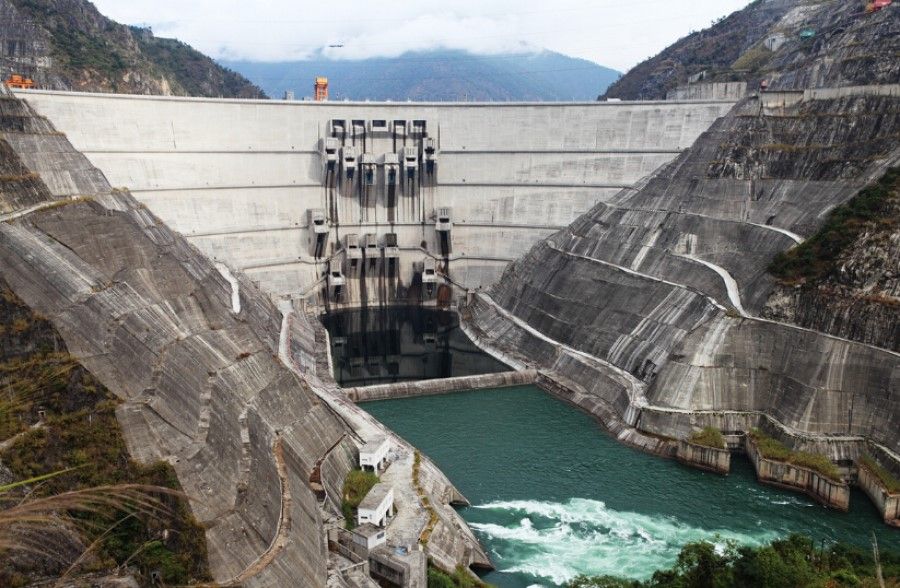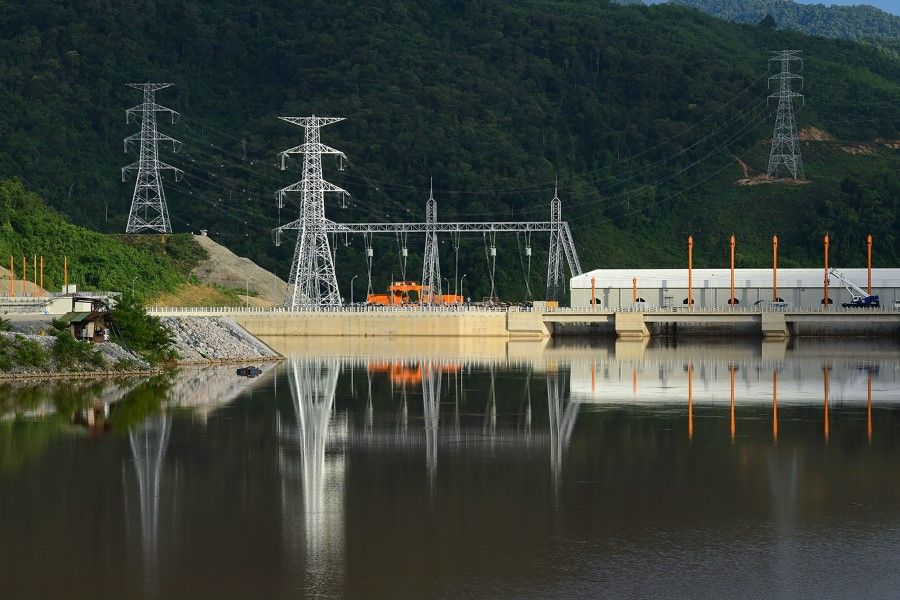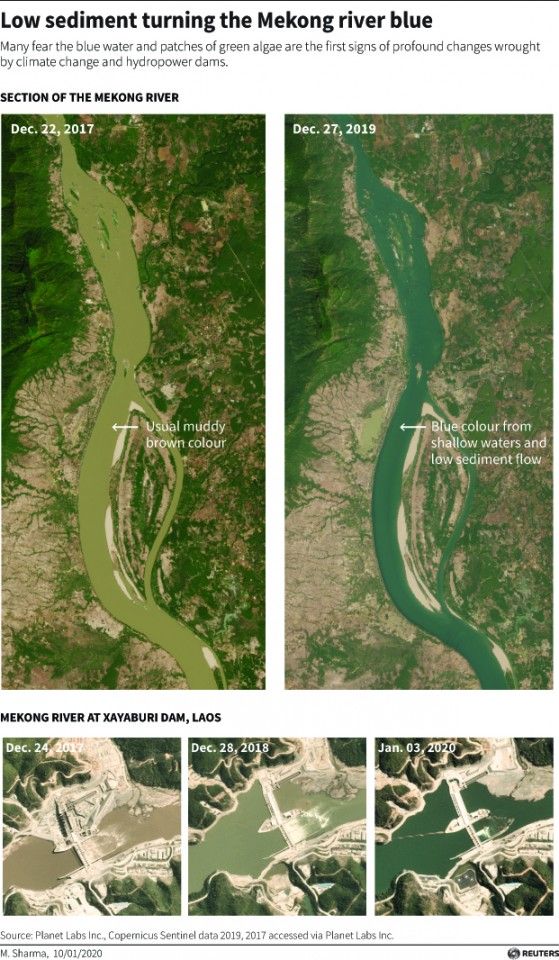The Mekong River's future and the role of China

In the course of 2019, sustained drought in southern China and mainland Southeast Asia brought water in the Mekong River to its lowest levels in 30 years. This disturbing development has focused attention on the major changes to the river's character stemming from China's construction of hydroelectric dams on the river's course in its territory. And this concern has been heightened as, over the past decade and for the first time ever, dams have now been built on the Mekong after the river flows out of China.
Against this background, climate change and its effects on the Mekong have become features that can no longer be ignored. The melting of the Himalayan glaciers in areas around the Mekong's source call into question the reliability of future inflows of snowmelt - these could increase before decreasing - while doubts have been raised by the apparent rise in the frequency of droughts over the river's lower reaches since the beginning of the present century.
A dammed river
With the Mekong often treated as a secondary issue by comparison with contemporary politics, far too little attention has been given to the fact that the character of this great river has been fundamentally transformed in the space of only four decades, beginning in the 1980s.
Once essentially a 'wild river', running uninterrupted from its source in eastern Tibet and then through or between Myanmar, Laos, Thailand, Cambodia and Vietnam to the South China Sea, its course is now interrupted by thirteen dams: eleven completed or under construction in China and two in Laos, both of which are set to be functioning by the end of the present year.

Moreover, China has indicated that it intends to build more dams in its territory. And plans exist for the construction of up to nine additional dams in Laos and Cambodia, although it is not possible to predict which, if any, of these will actually be built.
In addition to dams already built on the mainstream of the Mekong, many of the river's tributaries have been dammed, including such major rivers as the Nam Ou in Laos and the Se San in Cambodia. The consequences of this spate of dam-building have only slowly become apparent to a wider public though they have been of concern to specialist observers for many years.
But just as remarkable as the size of these dams is the fact that these developments in China have taken place without any formal consultation with those countries through which the Mekong flows downstream of China...
Additionally, large-scale clearance operations of obstacles in the river's course between 2000 and 2003 have opened the river for navigation between China's southern Yunnan province and northern Thailand; from Guan Lei to Chiang Saen. This development has greatly benefitted Chinese traders and led to a clear imbalance between the more powerful Chinese vessels and their Thai and Lao competitors. The Chinese vessels are aided, according to anecdotal reports, by selective releases of water from China's Jinghong Dam to aid their transit.
The scale, as well as the speed, with which this remarkable transformation has taken place deserves equal emphasis. Not least is this so because of the great size of several of the cascade of hydroelectric dams China has constructed. For example, the dam built at Xiaowan (construction began in 2002 and was completed in 2010) is the third tallest dam in the world with a dam wall rising nearly 300 metres in height, while the Nuozhadu dam (construction began in 2004 and was completed in 2012) has a massive storage capacity of 40,046 million cubic metres. But just as remarkable as the size of these dams is the fact that these developments in China have taken place without any formal consultation with those countries through which the Mekong flows downstream of China-from China's point of view it has every right to construct dams on its own territory without reference to other countries.

Population in the lower Mekong basin
While China's construction of dams has led to some resettlement of populations in Yunnan province, the numbers involved are very limited by comparison with the size of the population after the river flows into Southeast Asian territory. For it is in the downstream region, the Lower Mekong Basin (LMB), most particularly in Laos, Thailand, Cambodia and Vietnam, that no fewer than 66 million people live whose daily existence is closely linked to the Mekong.
Demographers estimate that no fewer than eight out of ten of those living in the LMB are dependent on the river for the fish catch taken from the river or for its role in agriculture and horticulture. As another important measure of the Mekong's centrality to the countries through which it flows, up to 80 per cent of the Cambodian population's animal protein intake comes from the fish caught in the Mekong River system, including most importantly the Tonle Sap lake.
The lack of an overarching authority
Complicating all developments associated with the Mekong is the fact that there is no overarching body or authority that has the power to regulate exploitation of the river, whether in relation to dam-building or navigation along its course - this comment applies to the Mekong River Commission, the American-sponsored Lower Mekong Initiative, and to the Chinese-promoted Lancang Mekong Cooperation organisation. And this situation reflects the essential fact that the Mekong is an international river. For while it is mainland Southeast Asia's longest river, 44% of the Mekong's course runs through Chinese territory where it is known as the Lancang Jiang (Turbulent River).
The Mekong, like all great rivers, needs to be considered in a holistic fashion. This means that arguments from China that only 16% of the water flowing into the Mekong is sourced from China are misleading since the importance of this input varies sharply throughout the year.
So, while there is now an increasing recognition that what is happening to the Mekong is a matter for serious discussion, there is no certainty as to how such action can be taken and coordinated. First and foremost is the need for recognition that any discussion of the Mekong's present and future needs to deal with the river as a whole. For the reality is that it is not possible to isolate developments on a geographical basis or in relation to one particular element affecting its functions. It is neither practical nor legitimate to discuss the construction of dams separate from the impact they have on fish migration and on agricultural production as a consequence of the blocking of sediment flow down the river.
The Mekong, like all great rivers, needs to be considered in a holistic fashion. This means that arguments from China that only 16% of the water flowing into the Mekong is sourced from China are misleading since the importance of this input varies sharply throughout the year. For instance, 40% of the water flowing past the Lao capital of Vientiane in the dry season comes from China. And research has already determined that dams built in China will have a direct and negative effect on fish stocks in the Tonle Sap where previously water from China contributed nearly ten per cent of the annual inflow.

Since it began its dam-building programme in the 1980s, China has repeatedly argued that its cascade of dams was beneficial to downstream countries through which the Mekong flows. In its most basic form, China's argument has been that the dams will 'even out' the flow of the river; minimising flooding and providing an improved flow of water during dry seasons. Yet because it regards its dam-building programme as an essentially domestic matter it has avoided discussion of the negative manner in which the river functions outside Chinese territory.
As a reflection of this position, China for many years declined to be more than an observer at the Mekong River Commission (MRC) set up as the result of the Mekong River Agreement reached between Laos, Thailand, Cambodia and Vietnam in 1995. The essential feature of the agreement was that it would provide a basis to coordinate plans for any infrastructure developments linked to the river.
Yet in itself, the Mekong River Agreement has proven to be a weak reed in relation to the governance of the Mekong. Its role and its powers have been widely misunderstood by many journalistic and academic commentators over the decades since its establishment. Most importantly, and despite its provisions for consultations between parties should one or other members choose to construct a dam in its territory, nothing in the Agreement precludes a government from doing so against the wishes of another country or countries. This has already been demonstrated by the government of Laos with the construction of the dams it has sanctioned at Xayaburi and Don Sahong. The first of these dams has just been commissioned and the second is due to come into operation at the beginning of 2020.
Above all, it has been the building of dams that has led to the negative developments that have already taken place and are prospective for the future, but the impact of proposals to expand navigation in Laos and the effects of climate change must also be considered. A summary of these three issues forms the remainder of this article.
Dams, decreased fish stock and sediment flows
At a most basic level, the dams already constructed on the Mekong have changed the river's flow pattern. Dams store water and so control its flow downstream, meaning that countries below China must depend on its goodwill to ensure that an adequate flow pattern takes place.

At the same time and in relation to the dams that have been built in Laos, the construction of dams carries with it the possibility of long-term and seriously damaging effects on fish stocks in the river. The dams built at Xayaburi and Don Sahong are located in key areas through which fish migrate - a large proportion of fish in the LMB are migratory. So, while the consortiums responsible for the construction of the two dams in Laos have claimed that they have made technical adjustments to ensure that migratory fish will not be blocked or destroyed by their dams' existence, these claims have been met by considerable scepticism from specialists.
The extent of short-term losses is difficult to predict, but in the longer term, a substantial fall in the number of fish caught in the Mekong would be a very serious matter indeed. It is not simply the fact that such losses would impinge on food supplies for millions of people, it is also the case that developing alternatives to fish catches - the production of pork, beef and poultry - would be notably more expensive in terms of capital, labour and indeed water.
Just as critically important in a negative sense is the fact that dams restrict the flow of sediment down the river, with suggestions that up to 90% of the total sediment flow in the river is generated within China. Estimates of the extent to which the dams already built in China and Laos have impeded the flow of sediment vary from location to location in the LMB, ranging from 40% to 60%. What is clear is the fact that China's dams, none of which are equipped with silt flushing mechanisms, are holding back large quantities of sediment. The reason for concern over the fact is that the sediment load in the river carries huge quantities of nutrients which are essential for agricultural and horticultural activities along the river, and nowhere more importantly than in Vietnam's Mekong delta.
What is happening in the delta is a matter for grave concern as saltwater incursions are increasing, partly as a result of climate change and partly as a consequence of drilling down into the water table to garner fresh water for the delta's agricultural activity. A steady decline in sediment flows is combining with these other negative developments to reduce the size of the delta and so its vital contribution to Vietnam's agricultural production.

Navigation of huge vessels
Until very recently commercial navigation of the Mekong River above Phnom Penh was limited to relatively small vessels because of the frequent presence of rapids in the riverbed. In particular, commercial navigation between northern Thailand into southern Yunnan province was restricted by the presence of repeated rapids and other obstacles in the river's course. This situation changed following an agreement between Thailand, Myanmar, China and Laos in 2000 that led to major clearances allowing vessels of up to 150 Dead Weight Tons to operate between Guan Lei and Chiang Saen. As already noted, the majority of the vessels operating over this stretch of the river are Chinese. Local residents in the region around Chiang Saen complain that the navigation that now takes place has had a clearly negative effect on fish catches.
Controversy now surrounds the plans by Chinese interests to extend navigation beyond Chiang Saen to Luang Prabang by removing the last major barrier currently impeding the passage of vessels, the Khon Pi Luang rapids close to the Thai town of Chiang Khong. As of now, local resistance appears to have preserved these rapids, which are regarded as a vital location for fish breeding. But if the rapids are removed, the Mekong will be open for navigation to Luang Prabang, and a great deal of dredging will take place along its course. The cost in terms of disturbance of fish migration and breeding patterns following such dredging will be very high.
Climate change
There is little cause for optimism in relation to the prospects associated with climate change and the LMB. Available research suggests that the extremes of both flooding and increased frequency of droughts are likely. And most worrying of all is that a combination of saltwater intrusion into the Mekong delta as the result of rising seawater levels and diminished sediment flow will result in a reduction in the area of the delta. The consequences for agricultural production in this vital region should this scenario come to pass will be dire.
Conclusion
Even if the speed and scale of the transformation of the Mekong River described in this article does not continue, there seems good reason to be concerned about its future and that of the populations dependent on it in the LMB. For the moment, plans to build further dams on the river in Laos and Cambodia are on hold, but a change in the consequences in terms of diminishing fish catches would be serious indeed. Above all, the problems associated with the river's current circumstances suggest an urgent need for efforts to start treating its future in a fashion that transcends national interests.
This article was first published as ISEAS Perspective 2019/105, 19 December 2019, "Why We Should be Worried about the Mekong River's Future: A Perspective on Forty Years of Great Change" by Milton Osborne.
